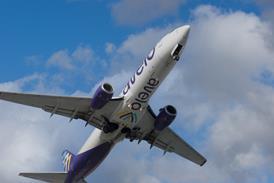Aer Lingus hopes to reignite plans to introduce the Airbus A321XLR into its fleet following the signing of a new labour agreement with its pilots in July.
The airline’s parent IAG withdrew plans in May for Aer Lingus to operate the A321XLR – also removing its status as the type’s launch carrier – citing a lack of assurance on cost structures at the Irish company.
Instead, IAG stablemate Iberia was made launch operator, with the Spanish carrier on track to put the new long-range narrowbody into service later this year to North American destinations such as Boston and Washington DC.

But speaking on IAG’s second-quarter earnings call on 2 August, Aer Lingus chief executive Lynne Embleton said she was “re-engaging” with the group’s management on the A321XLR joining the carrier’s fleet.
“Now we’ve got the pilot deal done, that brings structural changes that are useful for the company’s expansion,” she states. “We’ve got a narrowbody pay scale now, so I am re-engaging with Luis [Gallego, IAG chief executive] and Nicholas [Cadbury, IAG chief financial officer] on the possibilities of XLRs.”
Embleton says that the deal agreed with pilots, which involves a pay rise of 17.75% and followed industrial action at the carrier, brings two pieces of “structural change” that should address the parent company’s previous concerns.
“The first one is a new pay scale, or cap on the pay scale that applies to all narrowbody flying,” she states.
“That not only gives us the confidence to look at more narrowbodies – XLRs across the Atlantic – but it also means we get more productivity for the pilots that are flying between Europe, so they can do European flights and then they can do transatlantic flights, and that productivity benefit is going to be very useful to us in the future.”
Furthermore, the deal brings productivity improvements by removing a “crew agreement” that gave pilots more time off in summer and shorter working days.
“It was something they asked for several years ago but it did come at quite a significant productivity cost,” Embleton says. “We put it at around 7% productivity.”
Aer Lingus can therefore look forward to “better unit costs” in the future, she insists.
Embleton further notes that the pilot agreement is a four-year one, rather than the usual three-year deal, bringing more certainty to the business.
Responding to Embleton’s comments, IAG financial chief Cadbury says: “IAG are still considering what to do with the XLRs.”
The group has 14 of the type on order.
The industrial action by pilots in July had a €55 million ($60 million) impact on Aer Lingus’s finances, spread across the second and third quarters, Embleton says.
The carrier’s first-half profit dropped to €9 million, from €40 million a year earlier.
Airbus announced that the A321XLR had achieved European certification on the eve of this year’s Farnborough air show.


























